Page 1 of 476
TABLE OF CONTENTS
1
1Before drivingAdjusting and operating features such as door locks,
mirrors, and steering column.
2When drivingDriving, stopping and safe-driving information.
3Interior fea-
turesAir conditioning and audio systems, as well as other in-
terior features for a comfortable driving experience.
4Maintenance
and careCleaning and protecting your vehicle, performing do-it-
yourself maintenance, and maintenance information.
5When trouble
arisesWhat to do if the vehicle needs to be towed, gets a flat
tire, or is involved in an accident.
6Vehicle
specificationsDetailed vehicle information.
7For ownersReporting safety defects for U.S. owners and seat belt
instructions for Canadian owners
IndexAlphabetical listing of information contained in this
manual.
Page 4 of 476
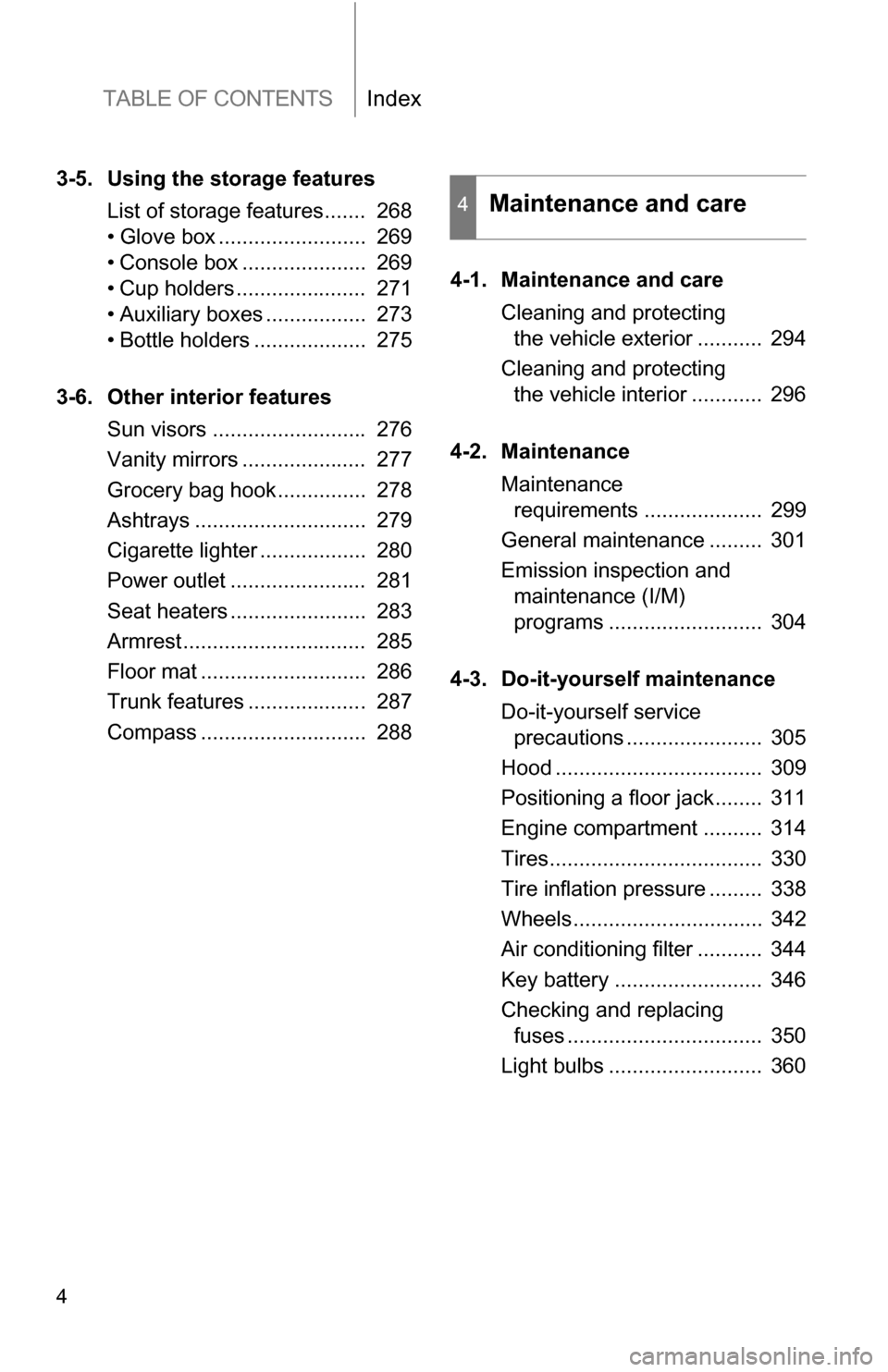
TABLE OF CONTENTSIndex
4
3-5. Using the storage featuresList of storage features....... 268
• Glove box ......................... 269
• Console box ..................... 269
• Cup holders ...................... 271
• Auxiliary boxes ................. 273
• Bottle holders ................... 275
3-6. Other interior features Sun visors .......................... 276
Vanity mirrors ..................... 277
Grocery bag hook............... 278
Ashtrays ............................. 279
Cigarette lighter .................. 280
Power outlet ....................... 281
Seat heaters ....................... 283
Armrest............................... 285
Floor mat ............................ 286
Trunk features .................... 287
Compass ............................ 288 4-1. Maintenance and care
Cleaning and protecting the vehicle exterior ........... 294
Cleaning and protecting the vehicle interior ............ 296
4-2. Maintenance Maintenance requirements .................... 299
General maintenance ......... 301
Emission inspection and maintenance (I/M)
programs .......................... 304
4-3. Do-it-yourself maintenance Do-it-yourself service precautions ....................... 305
Hood ................................... 309
Positioning a floor jack........ 311
Engine compartment .......... 314
Tires.................................... 330
Tire inflation pressure ......... 338
Wheels................................ 342
Air conditioning filter ........... 344
Key battery ......................... 346
Checking and replacing fuses ................................. 350
Light bulbs .......................... 360
4Maintenance and care
Page 5 of 476
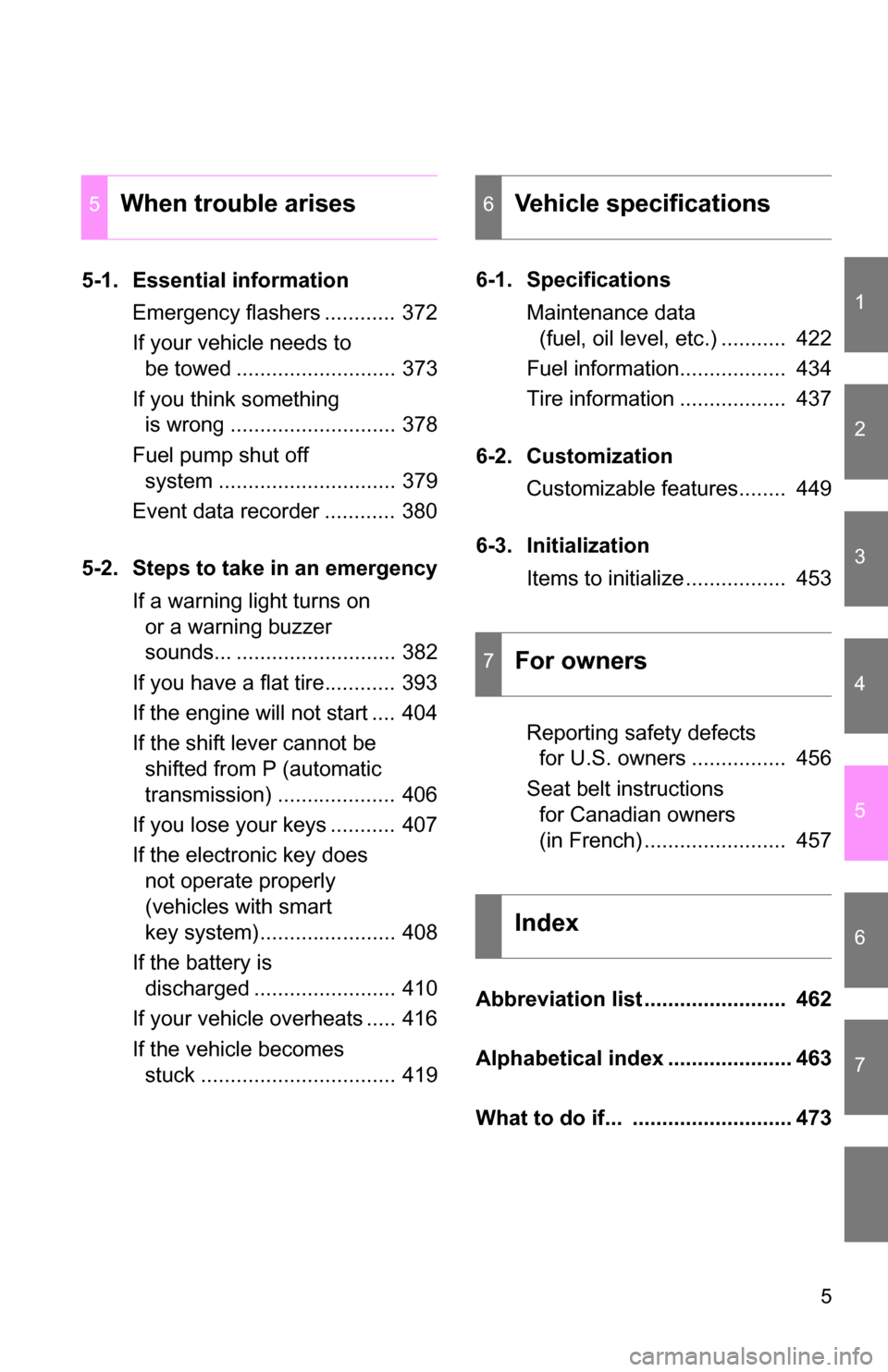
1
2
3
4
5
6
7
5
5-1. Essential informationEmergency flashers ............ 372
If your vehicle needs to be towed ........................... 373
If you think something is wrong ............................ 378
Fuel pump shut off system .............................. 379
Event data recorder ............ 380
5-2. Steps to take in an emergency If a warning light turns on or a warning buzzer
sounds... ........................... 382
If you have a flat tire............ 393
If the engine will not start .... 404
If the shift lever cannot be shifted from P (automatic
transmission) .................... 406
If you lose your keys ........... 407
If the electronic key does not operate properly
(vehicles with smart
key system)....................... 408
If the battery is discharged ........................ 410
If your vehicle overheats ..... 416
If the vehicle becomes stuck ................................. 419 6-1. Specifications
Maintenance data (fuel, oil level, etc.) ........... 422
Fuel information.................. 434
Tire information .................. 437
6-2. Customization Customizable features........ 449
6-3. Initialization Items to initialize ................. 453
Reporting safety defects for U.S. owners ................ 456
Seat belt instructions for Canadian owners
(in French) ........................ 457
Abbreviation list ........................ 462
Alphabetical index ..................... 463
What to do if... ........................... 473
5When trouble arises6Vehicle specifications
7For owners
Index
Page 7 of 476
7
Tires
●Rotation
● Replacement
● Inflation pressure
● Information
P. 330
P. 393
P. 431
P. 437
Trunk P. 46
Fuel filler door P. 74
Rear turn signal lights P. 140
Stop/tail and rear side marker lights
P. 155
: If equipped
Doors P. 40
Page 125 of 476
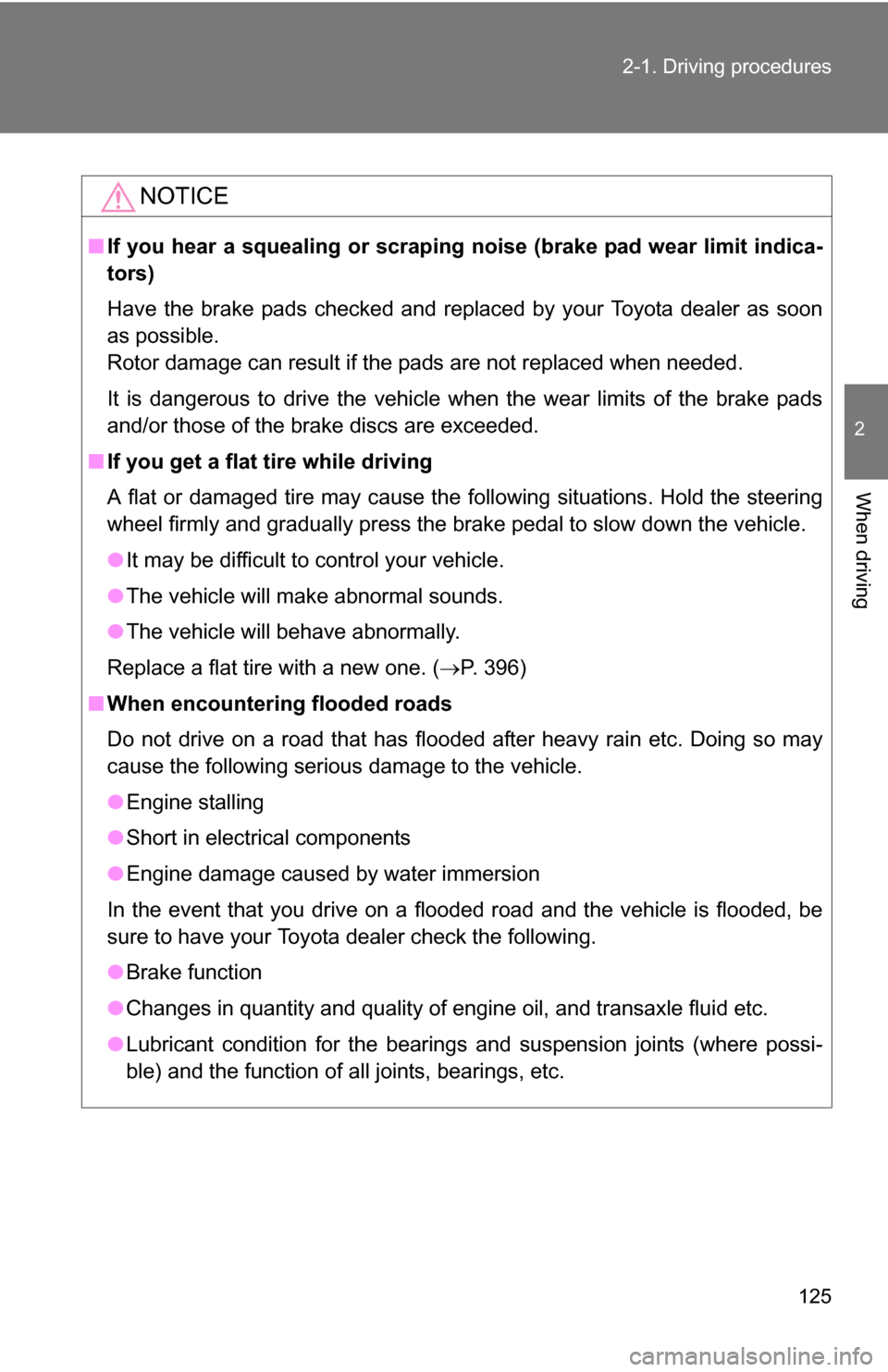
125
2-1. Driving procedures
2
When driving
NOTICE
■
If you hear a squealing or scraping noise (brake pad wear limit indica-
tors)
Have the brake pads checked and replaced by your Toyota dealer as soon
as possible.
Rotor damage can result if the pads are not replaced when needed.
It is dangerous to drive the vehicle when the wear limits of the brake pads
and/or those of the brake discs are exceeded.
■ If you get a flat tire while driving
A flat or damaged tire may cause the following situations. Hold the steering
wheel firmly and gradually press the brake pedal to slow down the vehicle.
●It may be difficult to control your vehicle.
● The vehicle will make abnormal sounds.
● The vehicle will behave abnormally.
Replace a flat tire with a new one. ( P. 396)
■ When encountering flooded roads
Do not drive on a road that has flooded after heavy rain etc. Doing so may
cause the following serious damage to the vehicle.
●Engine stalling
● Short in electrical components
● Engine damage caused by water immersion
In the event that you drive on a flooded road and the vehicle is flooded, be
sure to have your Toyota dealer check the following.
● Brake function
● Changes in quantity and quality of engine oil, and transaxle fluid etc.
● Lubricant condition for the bearings and suspension joints (where possi-
ble) and the function of all joints, bearings, etc.
Page 166 of 476
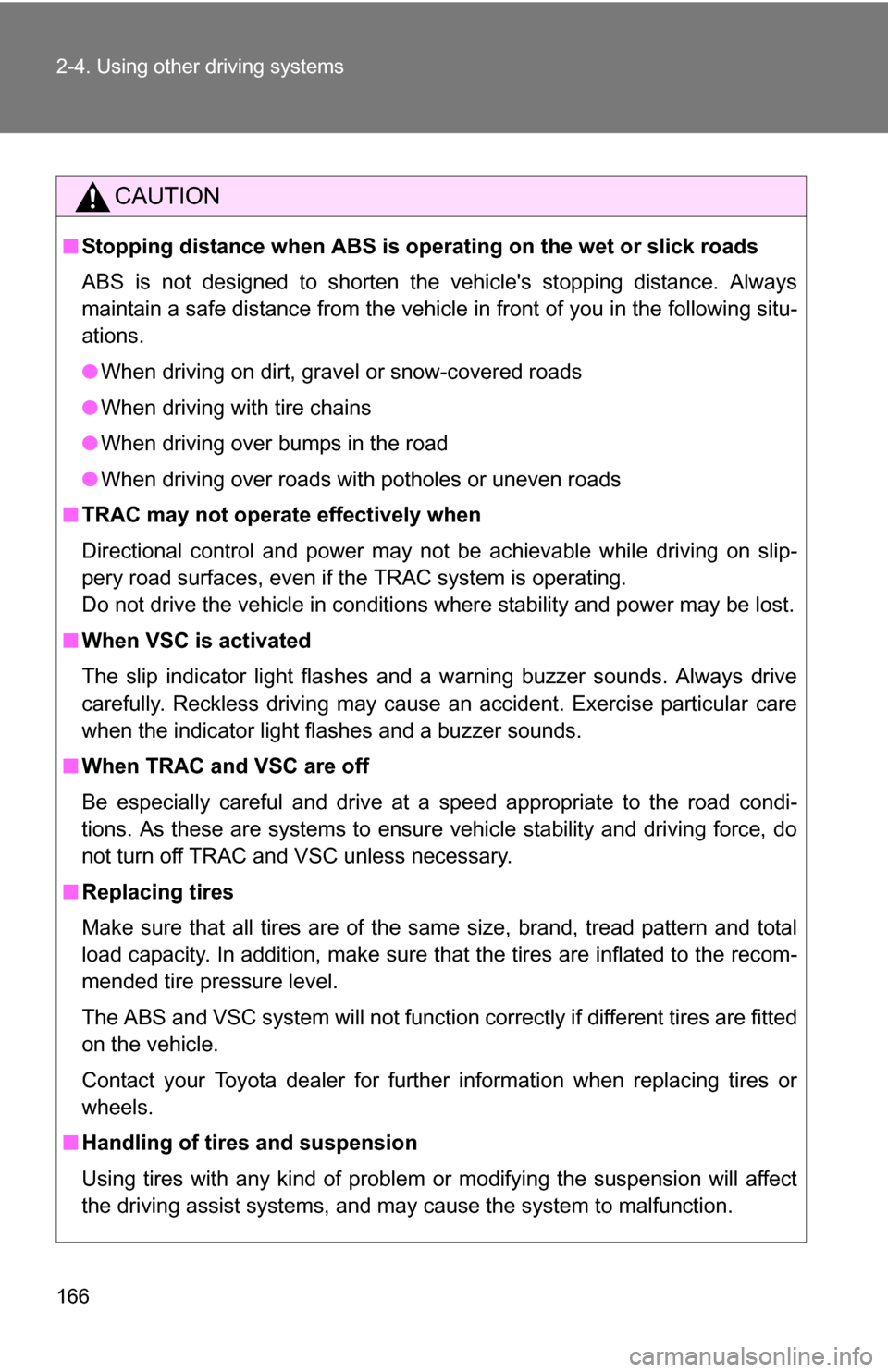
166 2-4. Using other driving systems
CAUTION
■Stopping distance when ABS is oper ating on the wet or slick roads
ABS is not designed to shorten the vehicle's stopping distance. Always
maintain a safe distance from the vehicle in front of you in the following situ-
ations.
● When driving on dirt, gravel or snow-covered roads
● When driving with tire chains
● When driving over bumps in the road
● When driving over roads with potholes or uneven roads
■ TRAC may not operate effectively when
Directional control and power may not be achievable while driving on slip-
pery road surfaces, even if the TRAC system is operating.
Do not drive the vehicle in conditions where stability and power may be lost.
■ When VSC is activated
The slip indicator light flashes and a warning buzzer sounds. Always drive
carefully. Reckless driving may cause an accident. Exercise particular care
when the indicator light flashes and a buzzer sounds.
■ When TRAC and VSC are off
Be especially careful and drive at a speed appropriate to the road condi-
tions. As these are systems to ensure vehicle stability and driving force, do
not turn off TRAC and VSC unless necessary.
■ Replacing tires
Make sure that all tires are of the same size, brand, tread pattern and total
load capacity. In addition, make sure that the tires are inflated to the recom-
mended tire pressure level.
The ABS and VSC system will not function correctly if different tires are fitted
on the vehicle.
Contact your Toyota dealer for further information when replacing tires or
wheels.
■ Handling of tires and suspension
Using tires with any kind of problem or modifying the suspension will affect
the driving assist systems, and may cause the system to malfunction.
Page 177 of 476
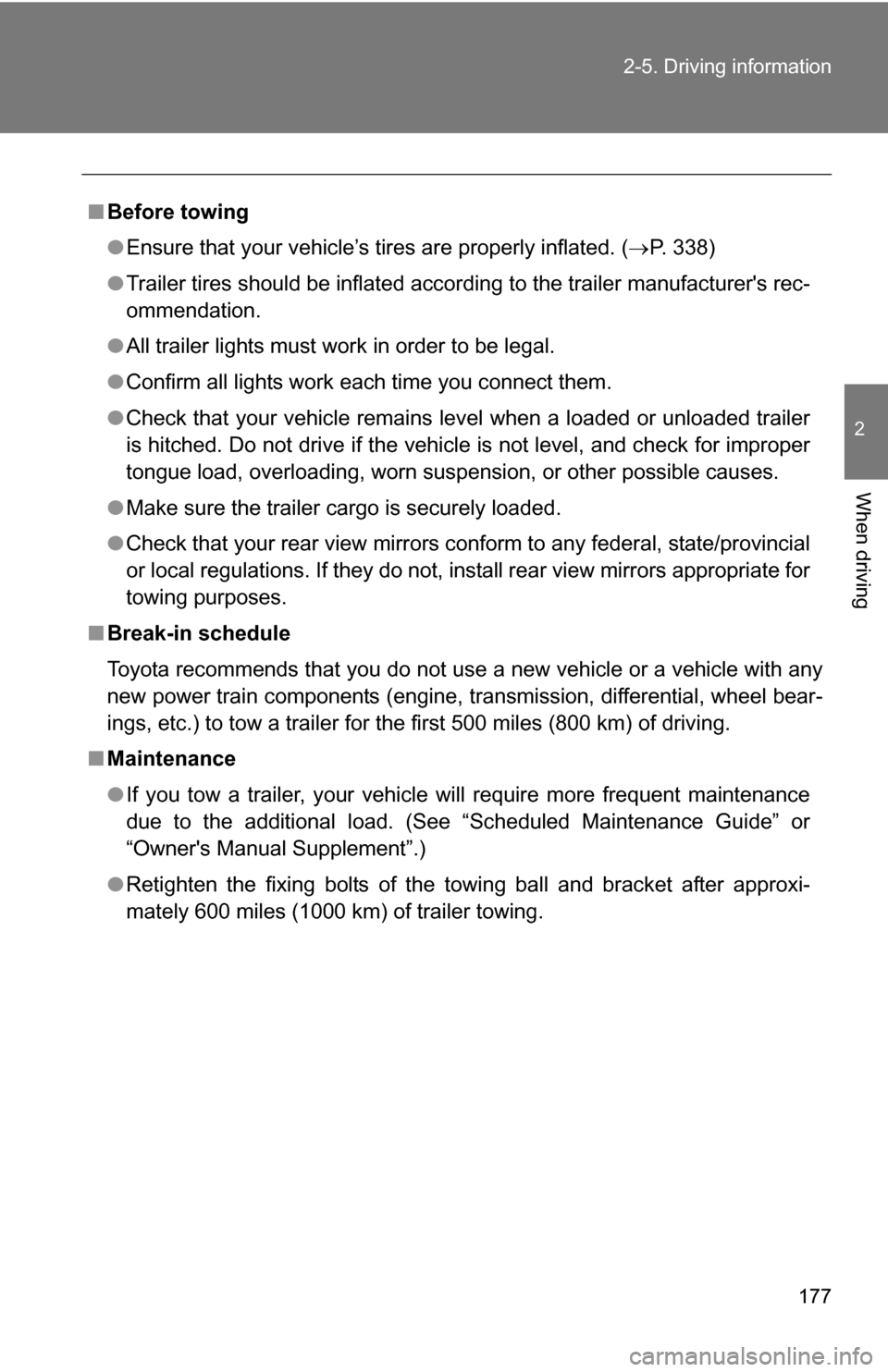
177
2-5. Driving information
2
When driving
■
Before towing
●Ensure that your vehicle’s tires are properly inflated. ( P. 338)
● Trailer tires should be inflated according to the trailer manufacturer's rec-
ommendation.
● All trailer lights must work in order to be legal.
● Confirm all lights work each time you connect them.
● Check that your vehicle remains level when a loaded or unloaded trailer
is hitched. Do not drive if the vehicle is not level, and check for improper
tongue load, overloading, worn suspension, or other possible causes.
● Make sure the trailer cargo is securely loaded.
● Check that your rear view mirrors c onform to any federal, state/provincial
or local regulations. If they do not, inst all rear view mirrors appropriate for
towing purposes.
■ Break-in schedule
Toyota recommends that you do not use a new vehicle or a vehicle with any
new power train components (engine, transmission, differential, wheel bear-
ings, etc.) to tow a trailer for the first 500 miles (800 km) of driving.
■ Maintenance
●If you tow a trailer, your vehicle will require more frequent maintenance
due to the additional load. (See “Scheduled Maintenance Guide” or
“Owner's Manual Supplement”.)
● Retighten the fixing bolts of the towing ball and bracket after approxi-
mately 600 miles (1000 km) of trailer towing.
Page 293 of 476
Maintenance and care4
293
4-1. Maintenance and careCleaning and protecting the vehicle exterior......... 294
Cleaning and protecting the vehicle interior.......... 296
4-2. Maintenance Maintenance requirements .................. 299
General maintenance....... 301
Emission inspection and maintenance (I/M)
programs........................ 304 4-3. Do-it-yourself maintenance
Do-it-yourself service precautions .................... 305
Hood ................................ 309
Positioning a floor jack ..... 311
Engine compartment ........ 314
Tires ................................. 330
Tire inflation pressure ...... 338
Wheels ............................. 342
Air conditioning filter......... 344
Key battery ....................... 346
Checking and replacing fuses .............................. 350
Light bulbs........................ 360